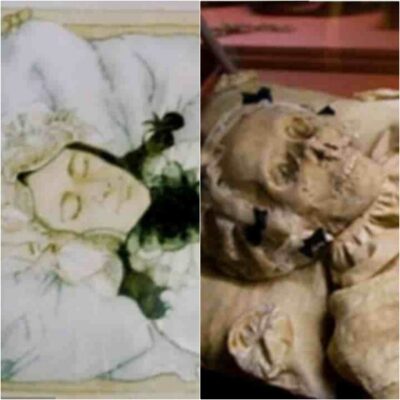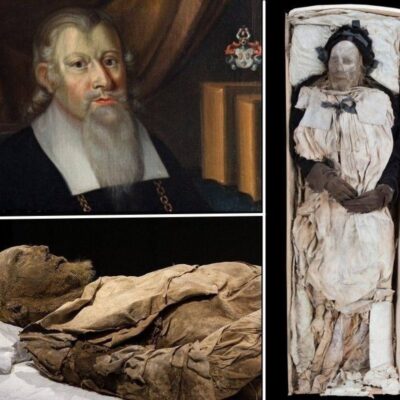If you visit La Paz, Bolivia, on November 8, you might wonder why throngs of people are congregating at cemeteries and walking about with decorated… human skulls.

The festival is known as Día de las Ñatitas, or Festival of the Skulls. People arrive at the central cemetery at the crack of dawn with human skulls that have been decorated in a variety of ways, some with jewelry, caps, cigarettes, or even sunglasses. According to Culture Trip, some of them are transported in cardboard boxes while others are in delicate wooden crates.

A celebration takes place after the skulls are set up on a bed of flowers. After a full day of partying and spending time with the skulls, known as the “ñatitas” in the local Aymaran language, musicians will perform for them, and it is believed that a good connection will be made with the spirit, bestowing you with good fortune (via Culture Trip).
DÍA DE LAS ÑATITAS

The Aymara people, who are from the Andes’ Altiplano region, are the source of the Día de las Ñatitas celebration (via Smithsonian). Six of the seven souls in a person’s body, according to Aymara belief, leave the body after death to enter the afterlife, while the seventh soul stays in the skull (per Culture Trip). After the body is buried, the skull is excavated and given to someone with whom to establish a relationship—it need not be a family member. In fact, the majority of ñatitas are held by individuals who had no contact whatsoever with the subject when they were alive.

The Aymara people have been holding the festival since before the arrival of the Spanish in what is now Bolivia in the 16th century, and it serves as a representation of their attitude toward death. The Festival of the Skulls is not a bad thing, says Milton Eyzaguirre Morales, head of outreach at Bolivia’s National Museum of Ethnography and Folklore. (According to Al Jazeera America) “This is a fundamental fact in the Andean context: Death is the origin of life. It’s not like in the Western concept, where death is something macabre.”

CONFLICTS WITH THE CHURCH
The ritual has been frowned upon by the Catholic Church since the first European encounter with the Aymara people. According to Smithsonian, the Spanish ordered the Aymarans to become Christians and tried anyone who performed rites involving skulls for necromancy and witchcraft. This, however, simply encouraged the rites to continue in secrecy or in remote locations where Aymaran farmers farmed.
Many of these farmers moved to the cities in search of employment in the 1970s, bringing their customs with them, which increased their popularity in the community (though the Catholic Church still frowns upon these rituals). When the La Paz church forbade visitors from bringing skulls onto its property in 2003, an enraged mob that was extremely proud of their custom damaged the edifice. According to Culture Trip, there has since been a debate regarding the blending of two seemingly incompatible cultural concepts.
EVO MORALES’ IMPACT

The Da de las Atitas and Aymaran culture in general gained prominence under Bolivia’s Evo Morales presidency. Aymaran Morales served as president of Bolivia from 2006 until 2019 before stepping down over alleged irregularities in the 2019 presidential election. The New York Times reports that allegations that Morales and his party tampered with the election results have been refuted.
Helping indigenous communities was one of Morales’ primary concerns throughout his administration and he put a lot of effort into it. Changing the old Republic of Bolivia’s name to the Plurinational State of Bolivia, which accorded 36 indigenous people groups formal recognition, was one of his major policies, according to The Guardian. Parts have attempted to make efforts to roll back his government’s kindness toward the Aymaran people since he was forced to quit in 2019, such as a lawmaker who allegedly labeled Aymaran rites as “satanic,” according to The Guardian.
HISTORY WITH SKULLS

Each “ñatita” in Aymaran culture has a distinct personality, and it is believed that if you have a good relationship with your “ñatita,” it will protect your house. It differs from the Day of the Dead in Mexico, where Smithsonian claims that celebrating ñatita is a means to pay respect to your ancestors. Instead, many of the “ñatita” that individuals in Aymaran culture possess are heirlooms that have been passed down or even purchased from certain vendors and have unique personalities, just like real people.
These “ñatitas” are frequently gathered from nearby cemeteries and medical students, so it’s not necessarily certain that you’ll get along well with your “ñatitas.” For centuries, the Aymaran people had buried skulls where they would plant crops as a way to bless the land and used them in religious ceremonies (via Smithsonian). There are several ideas about what you should do to serve your ñatitas, according to people like Ochoa Mollinedo (via Al Jazeera America), who says, “Some people say if you don’t make the offerings they will do bad things to you, but I don’t see it that way. I know he’s always going to love me and care for me. When I need him he’ll be there.”
ÑATITAS AFTER THE FESTIVAL

The action starts after sundown when the ñatitas are left at the cemetery and the folks head to prestas celebrations. The ñatitas are honored at the prestas, but the rest of the year they lead a somewhat quiet existence. According to Smithsonian, many people have many “ñatitas,” which are said to help with everything from protecting your home against burglaries to curing sick family members.
Some people think that ñatitas are helpful to businesses. In the city of La Paz, two ñatitas, Juanito and Juanita, assist the local police department in resolving crimes. According to the Smithsonian, police officers claim that the “ñatitas assistance” both helps offenders confess to their crimes and aids in case-solving. The “Da de las ñatitas,” or Festival of the Skulls, has become increasingly well-known over the past several decades, and it is certain to continue expanding in importance for many years to come in Bolivian culture.











